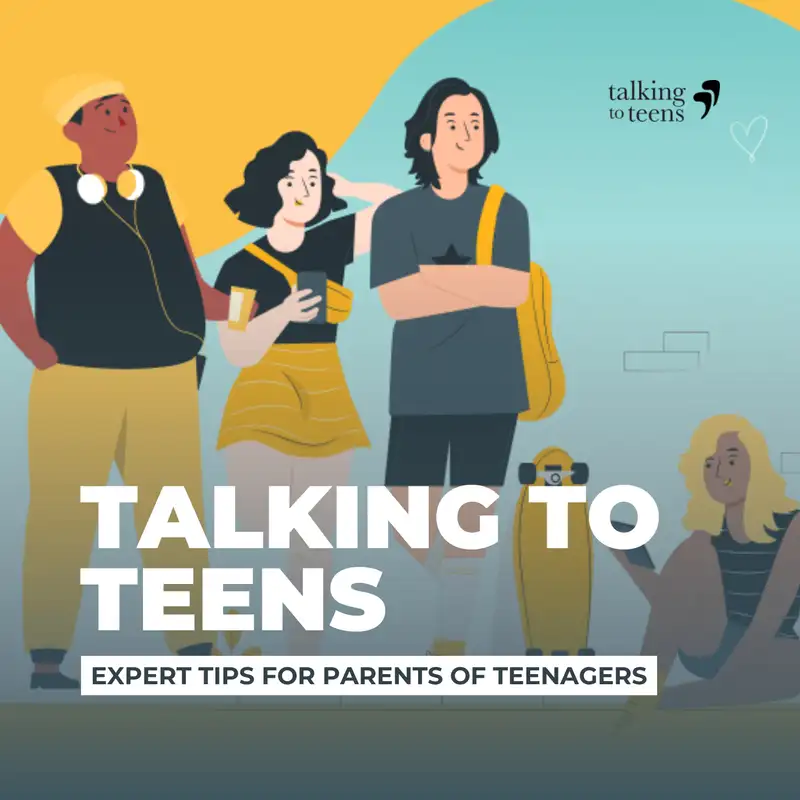Ep 188: Tuning In to Our Teens (and Ourselves!)
Andy:
The book is called Missing Each Other: How to Cultivate Meaningful Connections. Can you talk a little bit about what got you interested in this topic and what inspired you to write the book?
Ashley:
Absolutely. This has been a real passion project for us. We're both in the mental health field and met through research, kind of how our work got started. And we can talk more about that, but essentially through our work together we sort of fell into this area of trying to understand social connection better and trying to understand relationships and what makes good connections work, and how can people start to cultivate and develop that more in their own lives? Based on some of the work we had done in the past, we thought this would be exceptionally relevant to most people, and thought it would be helpful for the general audience.
Andy:
Awesome. And the book really centers around the idea of attunement. What is that exactly, and how does it work?
Ted:
Yeah, so we define attunement as the ability to tune into yourself, be aware of yourself and how you're feeling, as well as being aware of another person over the course of an interaction over the twists and turns of interaction. So kind of the classic example that would during a conversation, really tuning into the other person as well as yourself and what's happening between you. So that's a main example, but attunement also comes up in other kinds of interactions as well. So it could be playing sports with someone, if you're a teammate going down the field with them, or playing music with someone, dancing with someone.
Andy:
What is the quiet alert state?
Ted:
This concept of attunement, as you can imagine, it's really complicated. This process of staying in tune with yourself and another person over an interaction. And so what we do in the book is we break it down into components because our goal here is to help readers really understand it. It helps to break it down into parts.
Andy:
Yeah.
Ted:
The analogy we use is kind of like learning to play a sport. At first, when you're learning to play that sport, you usually break it down into fundamental skills and then putting it all together. So for attunement, we break it down into these four parts. The first part called relaxed awareness. And it's this combination of being really aware of what's going on around you and inside of you while staying relatively calm and relaxed. And in the book, we give some examples of people who are really unusually outstanding at doing this, like sports stars like Michael Jordan and Michael Phelps and Katie Ledecky, and so on.
Ted:
But then we make the point that yes, people vary in their ability to do this, but all of us have some capacity to have a state of relaxed awareness. And babies go in and out of different states, depending somewhat on whether they've eaten, whether they're hungry, whether they're wet, whether they're tired, things like that. But when their basic needs have been met, they're not hungry, they've gotten enough rest, and they're comfortable, they can be in something called the quiet alert state where they're very alert to what's going on around them and who's around them, but they're calm.
Ted:
So, they have this sort of calm alertness or quiet alert state. And it's in that state that babies do most of their interacting with their parents or caretakers or whatever. That's when they really start to relate to other people. We bring that up just to say that we have this in us, it's innate, it's natural to be able to get into this kind of state. But over the course of our lives, and in our adult lives, we have so much coming at us and so many stresses that it's easy to sort of lose touch with that and almost lose skills in that area.
Andy:
In today's world, don't we have more opportunities to connect with people than ever before? We can connect with people on LinkedIn and on Twitter, and then leave them a comment on Facebook. So why do we need a book on meaningful connections? Isn't it just easy?
Ashley:
That's a great question. I think a lot of people wonder that. We're currently the most connected we've ever been. And I think our argument is to think about the quality of those connections and what that looks like in the online format versus in person. The idea of connecting both in terms of what you're saying and how you're understanding one another, but also in terms of non-verbal communication as well. There's so much rich information and nuance that you can receive from someone's non-verbal communication, and that's one thing that's missing an online communication that generally, I think, lends itself to deeper connection. And just having that sort of feedback from another person with the comments and the retweets, it's sort of a disjointed type of connection rather than an actual interaction that sort of requires a whole host of different skills.
Andy:
There is a quote I love in here from Tony Morrison. It says, "Let your face speak what's in your heart." And I think a lot of times we don't do that, or there's a misalignment. We communicate disapproval when we don't necessarily mean to. So how can we recognize when that's happening and just really make sure that what our teenager reads on our face is really what's in our heart, what we really mean to be communicating?
Ashley:
I love this quote. And I think it goes back to this idea of non-verbal communication and how important that is and how much information gets communicated non-verbally, and to not underestimate that. And so, in a way, I'm sure a lot of us have this experience that has manifested in different ways, but I know I've been in that situation where my parent is looking at me with a sort of expression. And if I were to ask them about what they meant by that expression, I'm sure they meant it to be full of love, to be full of concern in terms of making sure that they are assessing that you are safe, that everything is taken care of, that you are set up for success, right? But that level of concern can sometimes look a different way to the child who is inevitably oftentimes looking for approval. And if they're not hearing that verbally, they might be interpreting what you're seeing non-verbally. And so thinking about how to reconcile and making sure that you are communicating both verbally and non-verbally in a way that is consistent with one another and matches.
Andy:
And one of the exercises you recommend for developing relaxed awareness is standing meditation. Why is that? I've heard of sitting meditation in the cross-legged pose.
Ashley:
I can imagine the question is kind of, why is that helpful?
Andy:
Yeah.
Ashley:
One thing that we tried to do really consciously in the book is to create a set of exercises that are scaffolded. And what I mean by that is to have a sort of approach where you're building on exercises. So we start with describing ones where you can just be sitting, you can do them alone, and eventually building up to ones where you could be standing like you're saying, walking even, or doing these exercises with other people, which is ultimately the goal because we want you to be able to develop these skills in a way where you can take it with you and make it most relevant in your interactions and conversations, especially challenging ones.
Andy:
Yeah.
Ashley:
So, the standing exercise in particular is helpful for, I would say number one, learning to ground yourself. That can be helpful with is cultivating an awareness of how you're feeling physically. Noticing tension within your body over time, noticing ways to release that tension and develop a sort of relaxed state within yourself while also being aware of your surroundings. That goes towards the definition of attunement, which is ultimately developing that sense of relaxed awareness in conversation, right? But I think part of what we're saying is, sometimes it can be really hard, especially as parents, to parse through the intense emotions or stresses or confusing emotional experiences you might be having, especially in light of challenging relationships like with a teenager or with a partner.
Andy:
Yeah.
Ashley:
And so just learning to develop that awareness of your physical body first can be a good starting point to then launch off into the overall mind body connection.
Andy:
What is interoceptive awareness?
Ted:
That gets at what we call the second component of attunement. So we talked a little bit about relaxed awareness, which is this sort of foundational state that you can develop through exercises like mindfulness exercises, including standing that Ashley just talked about. And then the second component of attunement is what we call listening. That means listening to the other person, what they're saying, and all of their cues, but also listening to yourself. So checking back in with yourself, how am I feeling during this moment?
Ted:
And part of listening to yourself is the concept of interoceptive awareness. So interception means literally feeling sensations from inside your body. So it could be things like being aware of your heart racing or being aware of just how your body's feeling in general. Are you feeling tense, et cetera? So one of the ways to develop attunement in general is to develop some of this interoceptive awareness. And it can also be a nice starting point because some people have trouble tuning into themselves and even knowing or describing how they're feeling. So sometimes thinking about physical sensing is a kind of easy to understand, concrete starting point. I kind of tune into how quickly my heart is beating or if it's beating really hard and fast or something like that.
Ashley:
I would also add that, that can manifest in different ways. So kind of a funny example is if you think of somebody that's really hungry or tired and they're not able to label that, it might look like a really irritable outburst or an annoyed expression, which obviously can have ripple effects in conversation or interactions, right? So thinking about how to develop and cultivate that awareness earlier and earlier to be able to avoid those negative responses or think about alternative ways of responding to sort of communicate your state of mind and body. But first, you have to be able to label it and identify it yourself.
Andy:
I thought this was really interesting, because we think about listening as something that we do focusing on the other person. And it's all about hearing what they're saying and noticing what they're trying to communicate. But a lot of times we neglect the other side of listening, which is getting more in touch with how what they're saying is affecting us, what our own interstate is. I love this idea, and I wonder how we can deepen our level of interoceptive awareness.
Ted:
Well, and we suggest in the book the series of exercises that some of which come from classic mindfulness exercises, if your listeners are familiar with those. And some of which come from Tai Chi.
Andy:
Yeah.
Ted:
Which is sort of like a kind of moving mindfulness discipline. Basically, to break it down a little bit, many of your listeners probably know that in mindfulness meditation, one of the things you do is you become aware of your posture, the way you're holding yourself, your alignment, and then you feel your breath. You pay attention to your breath. And even that right there alone is a form of interoceptive awareness, just body awareness, body alignment, feeling your breath. Also, relaxing certain parts of your body. So to get into the right alignment, we say, "Feel as if your head is gently suspended from above, from the top point on your head, and then let your shoulders relax down." A lot of us carry a lot of tension in our shoulders, and we're not even aware of that, especially if you've been sitting at a computer all day or something like that. Or even if you're in a difficult conversation with your teenager, you might start to really tense up in ways you're not even aware of.
Ted:
So, I think the ability to be aware of that, to feel, "Oh, my goodness, my shoulders are really tense right now. I should just let them drop and release and so on." But if you start by doing that in calm moments when you're alone and you're deliberately working on this, and what we recommend is setting aside a little bit of time each day if you can, it could be as little as two, three minutes, five minutes a day to do some of these exercises. And so then when you are in a stressful situation, let's say you're having a tough conversation with your teenager, it's going to be a lot easier to have that interoceptive awareness of yourself if you've practiced it in calmer moments.
Andy:
Another thing that you guys talk about in the book is sort of jumping to conclusions. You say sometimes in a relationship we jump to conclusions because of repeated patterns from past interactions. We develop expectations of what we think someone is trying to say or what they mean based on other encounters we've had with them. And sometimes we might be right, but sometimes we're not right. This is especially with family members and with parent and teen relationships. This is really a common thing where we just assume that we know where they're coming from when maybe we don't. So I wonder how we can start to notice when we're doing this or when this is happening. And then how do we bring ourselves back into a state of really attunement and really seeing what they're really communicating?
Ashley:
That's a great question. And I think one of the hardest things to do, I mean, we talk about all the time. We wrote this book, we try and practice these exercises, and still we struggle with this exact example as well and continue to practice it. But I think one of the things to think about is, say we take an example where maybe the pattern that you are constantly coming across is getting into a power struggle with your child. In a situation like that, the first thing we would want to do is be able to identify it.
Ted:
Yeah.
Ashley:
People might think that's pretty obvious and the simplest part to do, but that can often be one of the hardest parts to know that that pattern is happening in the moment that it is. And so thinking about practicing some of the fundamental elements that we just have been talking about, to be able to do that, to be able to see and notice that, okay, I'm getting into this tornado that we've been in before. And so the next step can then be to pause, to be able to start to develop that ability to take a second. Oftentimes, like you're describing, based on and past experiences, sometimes we will react in the way that our bodies are conditioned to, or that our awareness is conditioned to. And so that reactivity often creates this domino effect, especially if the other person is used to this pattern as well. And so breaking any sort of chain, it starts with taking a single pause. And I just don't want to underestimate how important just that simple element can be, and how difficult that simple element can be.
Andy:
And we're here today with Ted Brodkin and Ashley Pallathra talking about how to connect more deeply with our teenagers, even when we're fighting. And we're not done yet. Here's a look at what's coming up in the second half of the show.
Ashley:
This theme keeps coming back, right? That it's very difficult to do all of these things. And to be curious about your child's perspective, all parents want to do that, but oftentimes there's so many things that get in the way of that, right? Maybe time, maybe just your emotional capacity to do that, maybe things like anxiety and concern for your child that gets in the way of being curious, for fear of all the potential outcomes that might come to fruition. And so again, it goes back to that idea of relaxed awareness, of being able to cultivate that within yourself. It's almost like putting the oxygen mask on yourself first to be able to build that capacity for trying to understand them better.
Ted:
If you need to confront your teen and you really need them to listen to you, but you're attuned enough to know, in this moment they just had a really long, stressful day at school and they had four exams and they had sports and they're completely exhausted and starving. This is not the right moment to confront them with something. Maybe we need to go home, have dinner, relax a little, and then talk about it. I think even while you're saying what you want to say, it can be helpful to kind of gauge a little bit and then maybe you can make some adjustments because, ultimately, even if you're confronting them with something, you do want them to hear you or listen to you or take in what you're saying. You don't want them to completely blank out and tune out.
Creators and Guests



